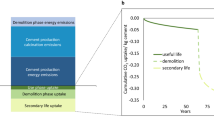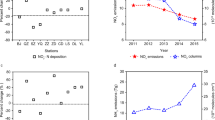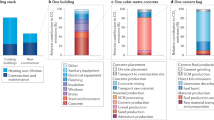Abstract
The renewal and expansion of the built environment within the context of rapid urbanization are imposing new benchmarks for resource management, particularly concerning the billions of tons of consumption and waste generation of concrete materials. The commercialization of carbonation in cementitious materials is underway, opening up possibilities for nitrogenation that has been well documented in recent experimental studies. Here we further utilize a dynamic model to estimate the mitigation potentials of NOx by the promotion of concrete nitrogenation in a global urbanization scenario, projecting its global health and economic benefits toward 2050. Our analysis reveals that concrete nitrogenation can theoretically contribute to a reduction in NOx emissions by approximately 3.4–6.9 Mt—or 6–13% of global industry-related emissions—in 2021. The cumulative economic potential is projected to exceed 150–160 trillion USD, accompanied by a NOx mitigation of 131–384 Mt between 2021 and 2050, equivalent to 75–260 years potentially lost to premature death and reduced quality of life (estimated in terms of disability-adjusted life years). However, both carbonation and nitrogenation techniques rely on the availability of alkaline reactive components within the material, leading to competition. Although significant uncertainty remains, our comparison reveals that, in most regions, promoting the commercialization of nitrogenation exhibits higher feasibility and prioritization over carbonation in relation to both economic and environmental benefits.
This is a preview of subscription content, access via your institution
Access options
Subscribe to this journal
Receive 12 digital issues and online access to articles
118,99 € per year
only 9,92 € per issue
Buy this article
- Purchase on SpringerLink
- Instant access to full article PDF
Prices may be subject to local taxes which are calculated during checkout






Similar content being viewed by others
Data availability
Please find the data used and additional methods in Supplementary Information.
References
World Energy Outlook 2018. IEA https://www.iea.org/reports/world-energy-outlook-2018 (2018).
McDuffie, E. E. et al. A global anthropogenic emission inventory of atmospheric pollutants from sector- and fuel-specific sources (1970–2017): an application of the Community Emissions Data System (CEDS). Earth Syst. Sci. Data 12, 3413–3442 (2020).
Simon, H., Reff, A., Wells, B., Xing, J. & Frank, N. Ozone trends across the United States over a period of decreasing NOx and VOC emissions. Environ. Sci. Technol. 49, 186–195 (2015).
Anenberg, S. C. et al. Long-term trends in urban NO2 concentrations and associated paediatric asthma incidence: estimates from global datasets. Lancet Planet. Health 6, e49–e58 (2022).
Huang, T. et al. Spatial and temporal trends in global emissions of nitrogen oxides from 1960 to 2014. Environ. Sci. Technol. 51, 7992–8000 (2017).
Emissions Database for Global Atmospheric Research (European Commission, Joint Research Centre & Netherlands Environmental Assessment Agency, 2022).
Skalska, K., Miller, J. S. & Ledakowicz, S. Trends in NO abatement: a review. Sci. Total Environ. 408, 3976–3989 (2010).
Gholami, F., Tomas, M., Gholami, Z. & Vakili, M. Technologies for the nitrogen oxides reduction from flue gas: a review. Sci. Total Environ. 714, 136712 (2020).
Deschênes, O., Greenstone, M. & Shapiro, J. S. Defensive investments and the demand for air quality: evidence from the NOx Budget Program. Am. Econ. Rev. 107, 2958–2989 (2017).
Silas, K., Ghani, W. A. W. A. K., Choong, T. S. Y. & Rashid, U. Carbonaceous materials modified catalysts for simultaneous SO2 /NOx removal from flue gas: a review. Catal. Rev. 61, 134–161 (2019).
OECD & European Commission. Cities in the world: a new perspective on urbanisation. OECD https://doi.org/10.1787/d0efcbda-en (2020).
Monteiro, P. J. M., Miller, S. A. & Horvath, A. Towards sustainable concrete. Nat. Mater. 16, 698–699 (2017).
World Population Prospects 2022: Summary of Results 38 (United Nations Department of Economic and Social Affairs, 2022).
Shah, I. H., Miller, S. A., Jiang, D. & Myers, R. J. Cement substitution with secondary materials can reduce annual global CO2 emissions by up to 1.3 gigatons. Nat. Commun. 13, 5758 (2022).
Duan, H., Miller, T. R., Liu, G. & Tam, V. W. Y. Construction debris becomes growing concern of growing cities. Waste Manag. 83, 1–5 (2019).
Liu, J., Chen, Y. & Wang, X. Factors driving waste sorting in construction projects in China. J. Clean. Prod. 336, 130397 (2022).
Zhang, N. et al. Potential for CO2 mitigation and economic benefits from accelerated carbonation of construction and demolition waste. Renew. Sustain. Energy Rev. 169, 112920 (2022).
Horgnies, M., Dubois-Brugger, I. & Gartner, E. M. NOx de-pollution by hardened concrete and the influence of activated charcoal additions. Cem. Concr. Res. 42, 1348–1355 (2012).
Ramakrishnan, G. & Orlov, A. Development of novel inexpensive adsorbents from waste concrete to mitigate NOx emissions. Build. Environ. 72, 28–33 (2014).
Patel, S., Orlov, A., Ariyachandra, E. & Peethamparan, S. Effect of flue gas temperature on NO2 adsorption by aged recycled concrete Waste: DRIFTS, TGA and BET study. Chem. Eng. J. 420, 130413 (2021).
Orlov, A. nitrogen dioxide sequestration using demolished concrete and its potential application in transportation infrastructure development. US Department of Transportation https://rosap.ntl.bts.gov/view/dot/31144 (2016).
Ariyachandra, E., Peethamparan, S., Patel, S. & Orlov, A. Chloride diffusion and binding in concrete containing NO2 sequestered recycled concrete aggregates (NRCAs). Constr. Build. Mater. 291, 123328 (2021).
Ma, Q., Guo, R., Zhao, Z., Lin, Z. & He, K. Mechanical properties of concrete at high temperature—a review. Constr. Build. Mater. 93, 371–383 (2015).
Liu, J. et al. Carbon and air pollutant emissions from China’s cement industry 1990–2015: trends, evolution of technologies, and drivers. Atmos. Chem. Phys. 21, 1627–1647 (2021).
Hasanbeigi, A., Bhadbhade, N. & Ghosh, A. Air pollution from global cement industry—an international benchmarking of criteria air pollutants intensities. Global Efficiency Intelligence https://static1.squarespace.com/static/5877e86f9de4bb8bce72105c/t/62ef78a371716a77fcb7790f/1659861171704/Cement+CAP+Study-final.pdf (2022).
Schiller, G. & Roscher, J. Impact of urbanization on construction material consumption: a global analysis. J. Ind. Ecol. https://doi.org/10.1111/jiec.13392 (2023).
Ortlepp, R., Gruhler, K. & Schiller, G. Materials in Germany’s domestic building stock: calculation model and uncertainties. Build. Res. Inf. 46, 164–178 (2018).
Cai, W., Wan, L., Jiang, Y., Wang, C. & Lin, L. Short-lived buildings in China: impacts on water, energy, and carbon emissions. Environ. Sci. Technol. 49, 13921–13928 (2015).
Zhang, N. et al. Mitigation of carbon dioxide by accelerated sequestration in concrete debris. Renew. Sustain. Energy Rev. 117, 109495 (2020).
Geng, Y., Sarkis, J. & Bleischwitz, R. How to globalize the circular economy. Nature 565, 153–155 (2019).
Gollin, D., Jedwab, R. & Vollrath, D. Urbanization with and without industrialization. J Econ Growth 21, 35–70 (2016).
Ariyachandra, E., Peethamparan, S., Patel, S. & Orlov, A. Effect of NO2 sequestered recycled concrete aggregate (NRCA) on mechanical and durability performance of concrete. Cem. Concr. Res. 137, 106210 (2020).
Berke, N. S. & Hicks, M. C. Predicting long-term durability of steel reinforced concrete with calcium nitrite corrosion inhibitor. Cem. Concr. Compos. 26, 191–198 (2004).
Ann, K. Y., Jung, H. S., Kim, H. S., Kim, S. S. & Moon, H. Y. Effect of calcium nitrite-based corrosion inhibitor in preventing corrosion of embedded steel in concrete. Cem. Concr. Res. 36, 530–535 (2006).
Oey, T. et al. Calcium nitrate: a chemical admixture to inhibit aggregate dissolution and mitigate expansion caused by alkali-silica reaction. Cem. Concr. Compos. 110, 103592 (2020).
Al-Amoudi, O. S. B., Maslehuddin, M., Lashari, A. N. & Almusallam, A. A. Effectiveness of corrosion inhibitors in contaminated concrete. Cem. Concr. Compos. 25, 439–449 (2003).
Karagöl, F., Demirboğa, R., Kaygusuz, M. A., Yadollahi, M. M. & Polat, R. The influence of calcium nitrate as antifreeze admixture on the compressive strength of concrete exposed to low temperatures. Cold Reg. Sci. Technol. 89, 30–35 (2013).
Li, F. et al. An overview on the effect of pumping on concrete properties. Cem. Concr. Compos. 129, 104501 (2022).
Acknowledgements
N.Z. gratefully acknowledges the financial support from the PhD program of the Leibniz Institute of Ecological Urban and Regional Development. J.Y. acknowledges the support from China National Key R&D Plan (2019YFC1904000).
Author information
Authors and Affiliations
Contributions
N.Z. contributed to conceptualization, methodology, data curation, modeling, visualization, formal analysis, result interpretation and writing—original draft. G.S. contributed to supervision, result interpretation and writing—review and editing. H.A. contributed to result interpretation and writing—review and editing. Z.C. contributed to result interpretation, supervision and writing—review and editing. B.X. contributed to visualization, resources and result interpretation. Y.S. contributed to writing—review and editing. H.L. contributed to resources, and result interpretation. H.D. contributed to conceptualization, writing—review and editing, supervision and project administration. J.Y. contributed to funding acquisition, writing—review and editing and supervision.
Corresponding authors
Ethics declarations
Competing interests
The authors declare no competing interests.
Peer review
Peer review information
Nature Cities thanks Arto Saari and the other, anonymous, reviewer(s) for their contribution to the peer review of this work.
Additional information
Publisher’s note Springer Nature remains neutral with regard to jurisdictional claims in published maps and institutional affiliations.
Supplementary information
Rights and permissions
Springer Nature or its licensor (e.g. a society or other partner) holds exclusive rights to this article under a publishing agreement with the author(s) or other rightsholder(s); author self-archiving of the accepted manuscript version of this article is solely governed by the terms of such publishing agreement and applicable law.
About this article
Cite this article
Zhang, N., Schiller, G., Azarijafari, H. et al. Contribution of concrete nitrogenation to global NOx uptake. Nat Cities 1, 457–468 (2024). https://doi.org/10.1038/s44284-024-00084-y
Received:
Accepted:
Published:
Issue Date:
DOI: https://doi.org/10.1038/s44284-024-00084-y



